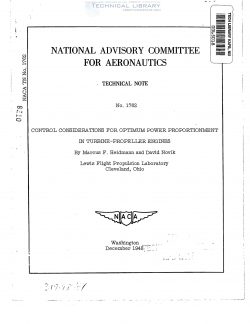naca-tn-1762
- Version
- 125 Downloads
- 1.34 MB File Size
- 1 File Count
- December 6, 2016 Create Date
- December 6, 2016 Last Updated
National Advisory Committee for Aeronautics, Technical Notes - Control Considerations for Optimum Power Proportionment in Turbine Propeller Engines

A turbine-propeller engine operating at constant speed was
analyzed in order to provide information relative to (1) factors
influencing optimum proportionment of power between propeller and
jet, (2) improvement in engine performance attainable from con-
trolled proportionment of power, and (3) control relations for
optimum proportionment of power.
The conditions for optimum proportionment of power were found
to vary with propeller characteristics for each propeller instal-
lation on a given engine. With the proper choice of a propeller,
the necessity for controlled proportionment of power is minimized.
When a propeller resulting in inefficient engine performance with
fixed power proportionment is used, however, substantial improve-
ment can be obtained with controlled proportionment. For the gen— -
eral case of an engine with varying propeller and turbine effi-
ciencies, a two- or three-position exhaust-nozzle area can provide
adequate optimum power proportionment. The theoretical expression
for a completely variable area is too complex to be directly
applicable toa practical control system.
In previous investigations it has been indicated that the
proportionment of power between the propeller and the Jet of a
turbine-propeller engine affects power output and it has also been
shown that the thrust output attains an optimum value dependent on
the proportionment of power (reference 1). This optimum is the
maximum net thrust obtainable for a given amount of power available
at the turbine inlet. Whether the gains to be derived from optimum-
power proportionmerrt are commensurate with the complexity of the
control apparatus required remains to be evaluated.
The gains and the complexity of <optimmn-powsr-proportionment
control have therefore been evaluated at the NACA Lewis labora-
tory. In this analysis, the proportionment of power is assumed to
be controlled by variations in the area of the exhaust nozzle. A
method by which the advantages of controllable exhaust-nozzle area
may be ascertained is presented and illustrated and the attendant
control problems are discussed. A theoretical analysis of optimum
power proportionment is evolved in which the optimum division of
power between the propeller and the Jet is shown to be a function
of propeller and turbine characteristics. In order to evaluate the
necessity for optimum power proportionment, typical engine and
propeller data are used to calculate the effect of variation in
exhaust-nozzle area on engine performnce.
| File | Action |
|---|---|
| naca-tn-1762 Control Considerations for Optimum Power Proportionment in Turbine Propeller Engines.pdf | Download |

Comment On This Post